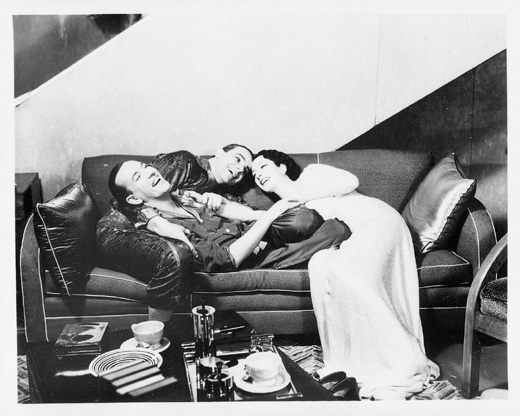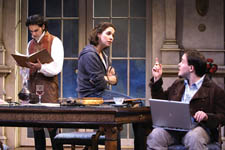“Unlike some highbrow critics, I love musicals–and not just old ones, either. But the new shows that opened in the season just past illustrate my belief that the Broadway musical is suffering from four chronic problems that are growing increasingly pronounced…”
Archives for May 2009
EXHIBITION
The Collage Aesthetic of Louis Armstrong: “In the Cause of Happiness” (Peter Jay Sharp Arcade, Frederick P. Rose Hall, Broadway at 60th St., up through Sept. 26). Now that a book of Louis Armstrong’s collages has been published, a growing number of music lovers are becoming aware that the greatest jazz musician of the twentieth century was also a gifted amateur artist who decorated the boxes that held his reel-to-reel tape collection and the walls of his New York home with colorful scissors-and-Scotch-tape assemblages of newspaper and magazine clippings whose freely associational quality recalls the “visionary art” of untrained painters. Jazz at Lincoln Center is currently mounting an exhibition of large-scale reproductions of Armstrong’s collages, and a selection of the fragile one-of-a-kind originals will also be on view at the Louis Armstrong House Museum in Queens through July 12. Both shows offer a fascinating glimpse of a little-known aspect of Armstrong’s proliferating creativity (TT).
CD
The Complete Louis Armstrong Decca Sessions (1935-1946) (Mosaic, seven CDs). Most jazz critics regard the late Twenties and early Thirties as Satchmo’s peak years, but a vocal and steadily growing minority begs to differ. This box set will give them plenty of ammunition. Armstrong had simplified and purified his flamboyant style by the time he signed with Decca in 1935, and no apologies of any kind need be made for the recordings he made with his big band and a delightfully wide variety of guest artists, including Sidney Bechet, Bing Crosby and the Mills Brothers. Put on “2:19 Blues,” “Darling Nellie Gray,” “Ev’ntide,” “Jodie Man,” “Jubilee,” “Nobody Knows the Trouble I’ve Seen,” “Struttin’ with Some Barbecue,” or “Wolverine Blues” and you’ll get the point instantly. Many of these 78 sides are comparatively unfamiliar, and all have been digitally remastered to gorgeous effect. Dan Morgenstern’s liner notes deserve a Grammy, or maybe a Nobel Prize. This one’s a must, and then some (TT).
BOOK
Judith Mackrell, Bloomsbury Ballerina: Lydia Lopokova, Imperial Dancer and Mrs. John Maynard Keynes (Phoenix, $14.95 paper). She was a star of the Ballets Russes whose long list of lovers included Igor Stravinsky and Heywood Broun. He was a world-famous economist, a member of the Bloomsbury circle, and a confirmed homosexual. They were, in short, the least likely of couples–but they fell in love, married, and lived happily ever after, much to the dismay of Keynes’ viciously snobbish friends, Virginia Woolf foremost among them. Their story had previously been told in bits and pieces, but Judith Mackrell, the dance critic of the Guardian, has now given us an impeccably well-written book that pulls a half-forgotten ballerina out of the memory hole and restores her to her proper place among the key figures of twentieth-century ballet. Lopokova’s marriage to Keynes turns out to have been a full-fledged romance on both sides, and Mackrell describes it with sympathy and candor. Rarely have I read a better dance biography–or a more touching love story (TT).
TT: Broadway’s no-hitter
I panned every musical that opened on Broadway in the 2008-09 season, revivals included. While this may well say more about me than it does about Broadway, I’m more inclined to think that my unfailing displeasure points to something amiss with contemporary musical comedy. In my “Sightings” column for Saturday’s Wall Street Journal, I argue that the Broadway musical is suffering from four chronic problems that have grown increasingly pronounced in recent seasons. To find out what they are, pick up a copy of today’s Journal and see what I have to say.
UPDATE: Read the whole thing here.
TT: Cross-country run (VI)
 The last few days of my cross-country reviewing trip were typically hectic. I traveled from Smalltown, U.S.A., to Washington, D.C., on Tuesday, a twelve-hour-long journey that seemed to last for at least a fortnight. That night I met a friend for dinner and a show, the Shakespeare Theatre Company’s revival of Design for Living, one of Noël Coward’s most interesting and, in my opinion, inadequately appreciated plays. On Thursday I returned to New York–this time, thank God, by train. I dragged two bags of snail mail home from the post office, took a suitcase full of dirty clothes to the laundry, went to the gym, and spent the evening on the couch, watching TV and doing as little as possible.
The last few days of my cross-country reviewing trip were typically hectic. I traveled from Smalltown, U.S.A., to Washington, D.C., on Tuesday, a twelve-hour-long journey that seemed to last for at least a fortnight. That night I met a friend for dinner and a show, the Shakespeare Theatre Company’s revival of Design for Living, one of Noël Coward’s most interesting and, in my opinion, inadequately appreciated plays. On Thursday I returned to New York–this time, thank God, by train. I dragged two bags of snail mail home from the post office, took a suitcase full of dirty clothes to the laundry, went to the gym, and spent the evening on the couch, watching TV and doing as little as possible.
Today I’ll be back at work with a vengeance. If you should happen to be in town for BookExpo America, you can catch me at the Javits Center: I’ll be signing bound galleys of Pops: A Life of Louis Armstrong at Table 19 from 12:30 to one p.m., then appearing on the Uptown Stage at 2:30, where Ben Moser will be interviewing me about Pops. Tonight I’m seeing a press preview of Coraline at the Lucille Lortel Theatre, and tomorrow I’m catching Norman Corwin’s The Rivalry, a play about the Lincoln-Douglas debates, at the Irish Repertory Theatre.
Sunday marks the start of a new theater-related adventure: Mrs. T and I will be flying north to Toronto to spend four days at the Stratford Shakespeare Festival, where we’ll be seeing Three Sisters, The Importance of Being Earnest, and Macbeth. You can’t get much eggheadier than that! Watch this space for details, though I don’t expect to do a whole lot of blogging from Stratford.
And so ends my first theater-related marathon trip of the summer of 2009. It’s been one hell of a sprint–I wouldn’t care to know how many miles I traveled–but I enjoyed nearly every minute of it, not counting the time I spent sitting on planes or in departure lounges. I only wish I could take a week off to pull myself together, but The Letter and ten more summer festivals await my presence, and I have miles and miles and miles to go before I sleep.
(Last of six parts)
TT: Shakespeare-style Stoppard
Today’s Wall Street Journal drama column contains reviews of the Folger Theatre’s revival of Arcadia in Washington, D.C., the American Shakespeare Center’s revival of Rosencrantz and Guildenstern Are Dead in Staunton, Virginia, and the Kansas City Repertory Theatre’s production of David Ives’ new adaptation of Georges Feydeau’s A Flea in Her Ear. Here’s a excerpt.
* * *
Most of the half-dozen American drama companies that perform in more or less authentic replicas of Elizabethan-era theaters specialize, logically enough, in the works of Shakespeare. From time to time, though, contemporary plays are acted on these modern re-creations of 17th-century stages, and it happens that two such productions are currently being performed in the same part of the country. In Washington, the Folger Theatre is mounting Tom Stoppard’s “Arcadia” on its indoor stage, while the American Shakespeare Center, located in Staunton, Va., is presenting Mr. Stoppard’s “Rosencrantz and Guildenstern Are Dead” in the Blackfriars Playhouse, a copy of a 1596 London theater. It’s a once-in-a-lifetime coincidence that these two shows are being performed within a three-hour drive of one another, and both are very much worth seeing.
 The Folger’s “Arcadia,” directed by Aaron Posner, is the more conventional of the two stagings: Daniel Conway’s solidly built proscenium-style set treats the surrounding theater as a shell rather than making use of its specifically Elizabethan features. But Mr. Posner and his fabulous cast need no scenic assistance in order to make magic out of Mr. Stoppard’s best play….
The Folger’s “Arcadia,” directed by Aaron Posner, is the more conventional of the two stagings: Daniel Conway’s solidly built proscenium-style set treats the surrounding theater as a shell rather than making use of its specifically Elizabethan features. But Mr. Posner and his fabulous cast need no scenic assistance in order to make magic out of Mr. Stoppard’s best play….
Unlike Mr. Posner’s “Arcadia,” which would have looked as good and played as well in a modern theater, Jim Warren’s knockabout staging of “Rosencrantz and Guildenstern Are Dead,” Mr. Stoppard’s topsy-turvy variation on “Hamlet,” is a site-specific production that makes impeccably idiomatic use of the wide-open stage of the Blackfriars Playhouse. No curtain, no sets, no spotlights–just a bunch of actors who come and go through a pair of upstage doors, speaking their soliloquies directly to the audience and moving briskly from scene to scene. The title roles are played not by two men but by a man and a woman, Rick Blunt and Ginna Hoben, who act in the broad, unselfconsciously vulgar manner of Shakespearean clowns….
David Ives, who rewrote Mark Twain’s “Is He Dead?” to extensive and brilliant effect a couple of seasons ago, has done a similar service on behalf of an infinitely better play. In Mr. Ives’ new version of “A Flea in Her Ear,” Georges Feydeau’s 1907 comedy about an impotent husband (John Scherer) whose wife (Carol Halstead) suspects him of adulterous dalliance, Feydeau’s fin-de-siècle French dialogue has been modernized (and Americanized) in a way that is fully faithful to the spirit of the greatest of all French farces. My guess is that this version, which is now making the regional rounds, will become the standard English-language version of “A Flea in Her Ear,” and anyone who sees the Kansas City Repertory Theatre’s immaculate production, directed by Gary Griffin, will come away certain that Mr. Ives has passed another theatrical miracle.
Mr. Griffin’s staging of “A Flea in Her Ear” is direct, vigorous and gimmick-free, thus allowing Feydeau’s meticulously engineered plot to work itself out with near-mathematical clarity….
* * *
Read the whole thing here.
TT: Almanac
“Perfection is a trifle dull. It is not the least of life’s ironies that this, which we all aim at, is better not quite achieved.”
W. Somerset Maugham, The Summing Up
